This post and the photos within it may contain affiliate links. If you purchase something through the link, I may receive a commission at no extra charge to you.
Are you confused about the difference between hand lettering and calligraphy?
Perhaps you didn’t even know that a difference existed between the two.
Don’t worry, you’ve come to the right place!
In this article, we will take a closer look at how exactly hand lettering differs from calligraphy.
Before we jump right in, let’s have a quick overview of the table of contents –
- The difference between hand lettering and calligraphy?
- What is calligraphy?
- What is hand lettering?
- What is typography?
- Understanding other terms (brush lettering, faux calligraphy, etc.)
- Why does all this matter?
- Summing it all up – final words.
Don’t worry, by the end of this post, you will have a clear understanding of the difference between these two art forms (and more).
Let’s dive right in!
If you prefer watching over reading, I’ve also made a YouTube video you can check out instead –
The difference between hand lettering and calligraphy is –
Although both hand lettering and calligraphy are visual art forms related to letters, their main difference is the method used to create the letters. Hand lettering focuses on drawing and illustrating the letters. Calligraphy, on the other hand, is the art of beautiful writing.
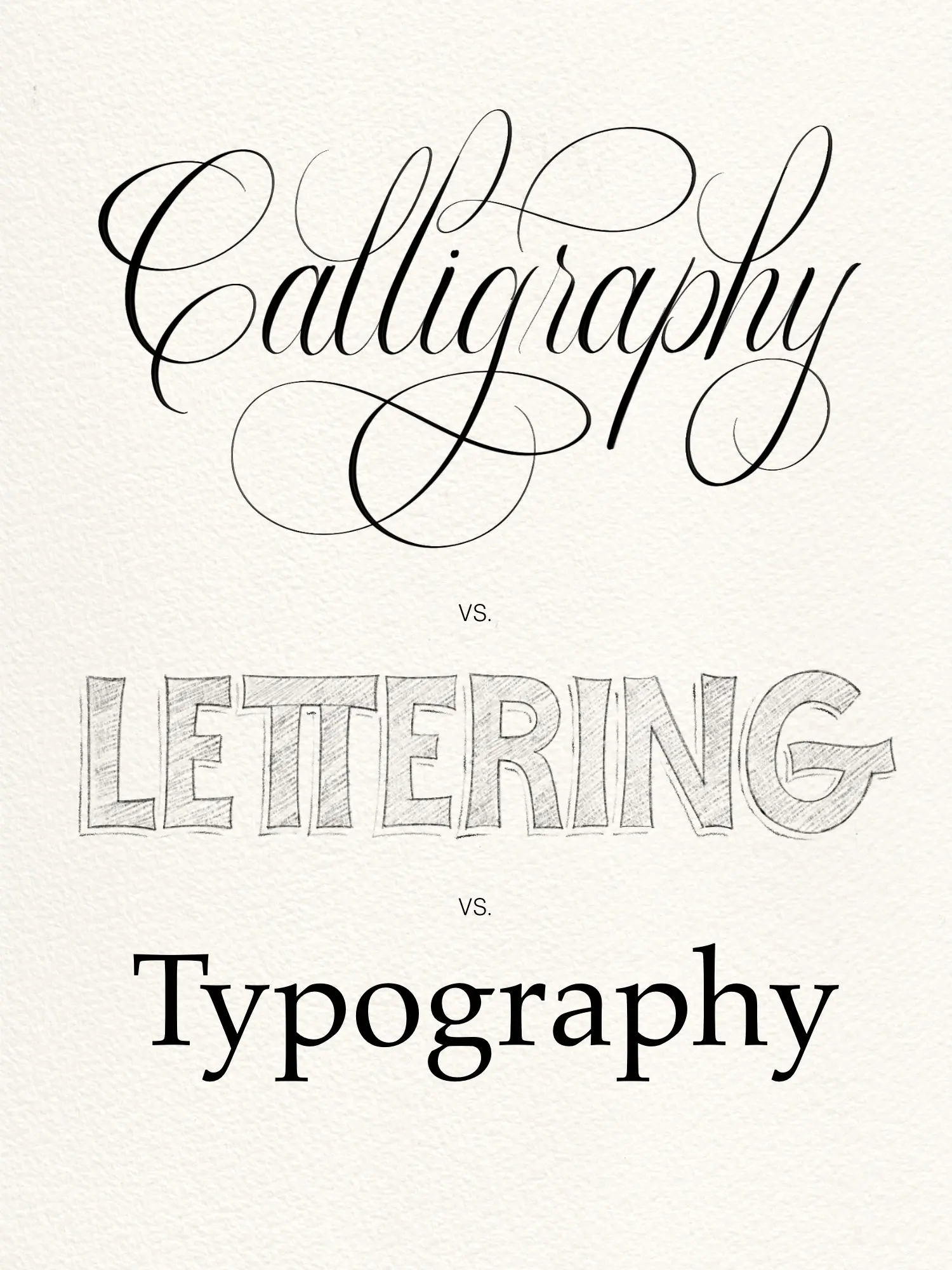
The image above is a visual example of the difference between hand lettering, calligraphy, and typography.
These terms are often used interchangeably. However, as you can see, they are quite different from each other.
In other words, the difference between hand lettering and calligraphy lies in the process and not the end result.
In the video below, I will create the same word in the (almost) same style, but one will be done in calligraphy and the other one in hand lettering.
Note – it’s quite understandable that if you are a complete beginner, you will struggle to spot the difference on a final piece (without seeing the actual process of creation). With time you will start developing your eye to notice these differences effortlessly.
Let’s look at these art forms to understand the whole story better.
What is calligraphy?
Calligraphy is a visual art form primarily focused on beautiful writing. Calligraphy is commonly created using specific tools such as a pointed nib, a broad-edged nib, a brush, etc. The emphasis here is on the writing aspect, meaning that the letterforms are usually executed in a single motion.
When we say calligraphy, we have to think of it as an umbrella term containing many different styles of writing.
First of all, calligraphy can be divided based on different cultures around the world, such as –
- Western calligraphy (the Latin alphabet)
- Chinese calligraphy
- Japanese calligraphy
- Arabic calligraphy
- Indian calligraphy
- Etc.
Here are a few quick examples.


For now, I solely focus on Western calligraphy.
With that in mind, let’s have a quick overview of the different styles of Western calligraphy.
With Western calligraphy, we should consider two major groups – Traditional and modern calligraphy.
It’s also important to mention that cursive writing is different from calligraphy.
Check out this post if you’re interested in learning more about how to improve your handwriting.
Traditional calligraphy –
Includes the calligraphy styles developed throughout the history of the Latin alphabet, which dates approximately since 600 BC.
To name a few traditional calligraphy styles –
- Roman capitals
- Uncials
- Insular minuscule
- Blackletter (gothic) styles
- The italic script
- Copperplate calligraphy
- Etc.
Here are a few traditional calligraphy examples from some of my favorite artists on Instagram.
I won’t bother you with the whole history. Still, if you are interested, I wrote a more in-depth article covering the development of the Latin alphabet throughout two-plus thousand years.
Quick note – When we talk about different calligraphy styles, we don’t refer to them as calligraphy fonts.
We refer to them as calligraphy styles or scripts. In today’s digital age, fonts are what computers use to write.
Modern calligraphy –
The easiest way to explain what modern calligraphy is – any calligraphy style that doesn’t follow the strict rules of traditional calligraphy.
I have a separate in-depth article on modern calligraphy and how you can get started with it. You can check it out here.
Another way that calligraphy differs from hand lettering is by using specific tools for writing.
You can use a pointed nib, a broad-edged nib, fountain pens, brushes, etc.
That all depends on the calligraphy style, you are working with.

Ok, now that you have a general overview of what calligraphy is, let’s proceed.
Quick note – Did you know that one of the best tools to start practicing calligraphy is just a regular pencil?
What is hand lettering?
Hand lettering is a visual art form that primarily focuses on drawing and illustrating letterforms by hand (hence the name). Unlike calligraphy, where we write the letters, with hand lettering, we are drawing the individual letterforms.
In hand lettering, the letters are most commonly drawn or sketched with a pencil and then outlined with various pens and markers.
In contrast to calligraphy, for hand lettering, you don’t really need a specific tool.
In fact, you can do hand lettering with pretty much any writing tool that you have.
Here are a few hand lettering examples from some of my favorite artists on Instagram.
Hand lettering is based on certain rules we use in both calligraphy and typography.
However, there are so many different ways you can stylize your letters.
If you want to learn and improve your hand lettering skills, you will, without a doubt, benefit tremendously by having even just a rudimentary understanding of typography and calligraphy.

I won’t dive into the details here, but I wrote an in-depth beginner’s guide on hand lettering and how you can get started with it. You can check it out here.
If you are interested to learn more about the different lettering styles, you can check out this article that I wrote.
What is Typography?
Typography is a visual art form that arranges letters (fonts) in a clear, legible, and visually appealing manner. It involves selecting typefaces, sizes, line lengths, letter spacing, kerning, and more.

Typography using moveable type can be dated all the way back to the 11th century.
However, a defining historical moment was the invention of the mechanical printing press machine by Johannes Gutenberg in 1439.
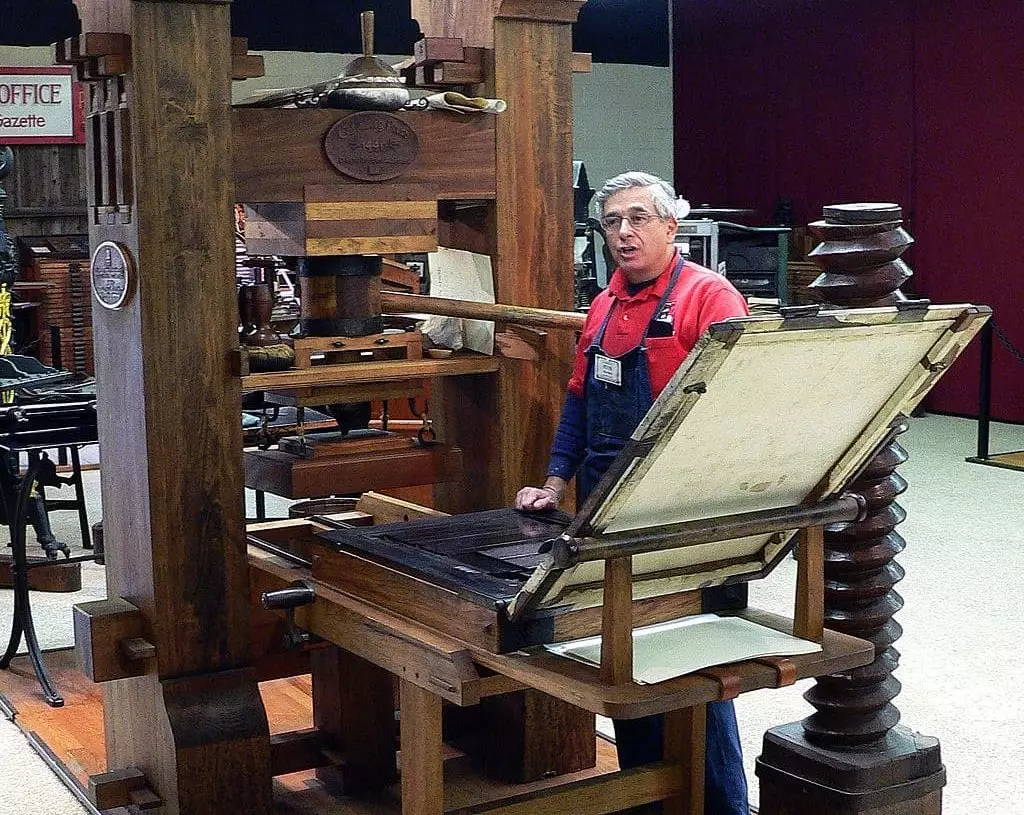
In the current digital era, typographers mostly work with premade computer fonts. Like the one you are reading right now (which is called Nunito btw.).
It’s also essential to distinguish type designers, which are the ones creating these insanely precise letterforms.
Interestingly enough, these letterforms are initially sketched on paper and then later digitized and polished to perfection.
Not only individually but also in combination with different letterforms, etc.
This is an extremely elaborate process that can take months or even years to complete.
Fun fact – The creation of one of the most popular and used typefaces in the 20th century – ‘’Futura’’ took three years to complete!
Understanding other terms (brush lettering, faux calligraphy, etc.)
Since this is an article about the different terminology, I figured it would be an excellent opportunity to shed some light on other commonly used terms.
Brush lettering –
This is a popularly adopted term that, in most cases, refers to calligraphy created with a brush pen.
To be 100% entirely correct, this would actually be brush calligraphy since you are actually writing the letters and not drawing them.
Nonetheless, I don’t think it’s necessary to take it that far, and it’s totally fine to call it to brush lettering. I also have an in-depth tutorial on brush lettering that you can check out here.
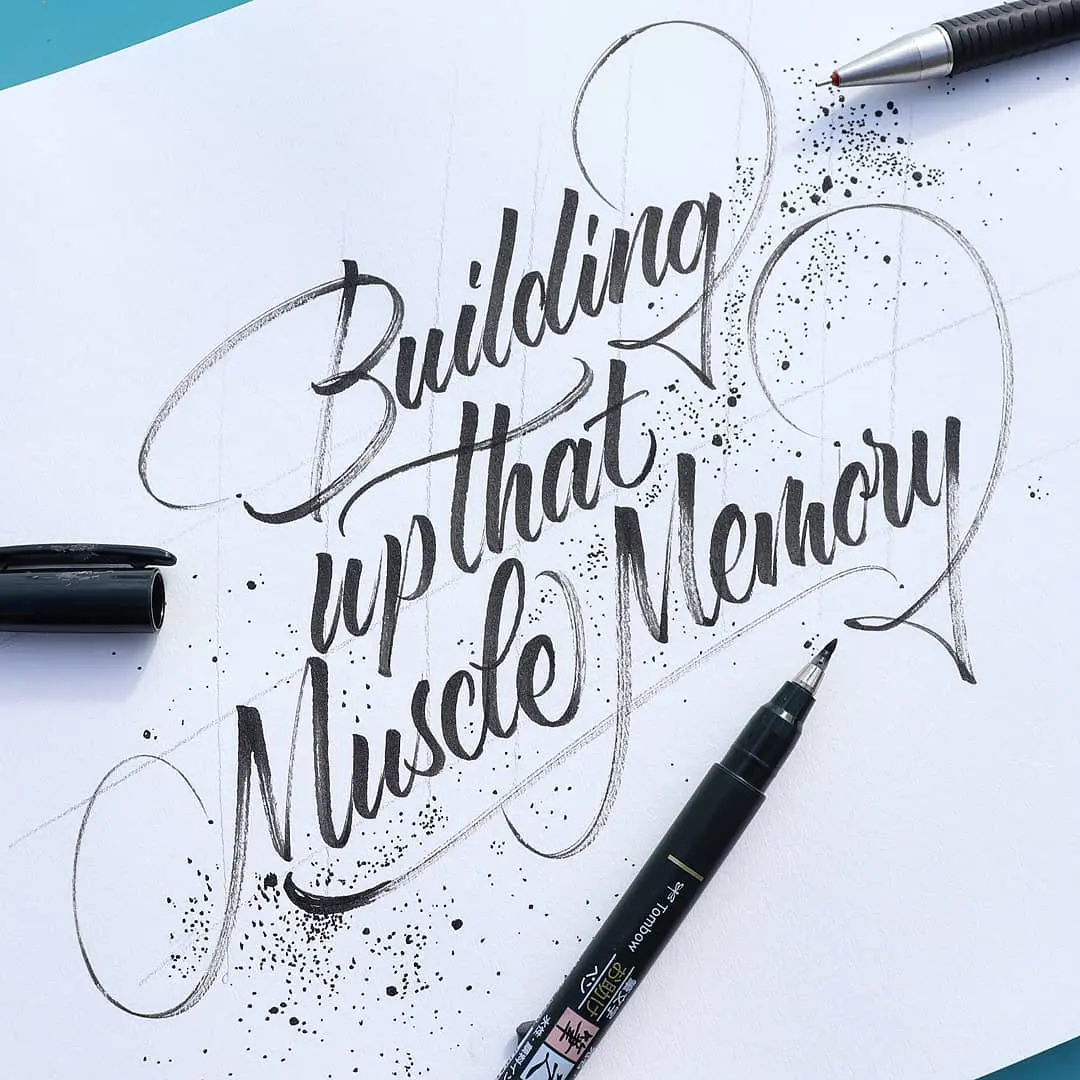
Faux (fake) calligraphy –
This one can be a bit tricky. I would say that it’s a combination of the two.
On one hand, you are technically drawing the letters, but you are doing so to imitate the look of calligraphy (hence the name).
I wrote an in-depth step by step tutorial for Faux calligraphy that you can check out here. It’s super fun and easy to get started with.

Sign Painting –
Sign painting is an art form that combines both calligraphy and hand lettering in its own unique way along with specific tools and techniques.
It’s an art form that picked up its popularity in the early last century to place advertisements on buildings, billboards, signboards, etc. (hence the name).
With the rise of the computer and digitalization (80’s), sign painting faced a steep decline in interest.
However, with the internet and social media era, sign painting, just like calligraphy, is seeing a significant comeback worldwide. If you are interested in getting started with sign painting, you can check out this beginner’s guide on my website.
I also wanted to mention one of my all time favorite documentaries called ”Sign Painters”.
Best of all,
It’s free to watch. Just click on the image below to visit the official website.

Chalk lettering –
Chalk lettering is pretty straight forward. It’s hand lettering done with chalk. Most commonly on a chalkboard or wall. And guess what? I have a step by step tutorial also for that 😀 You can check it out here.
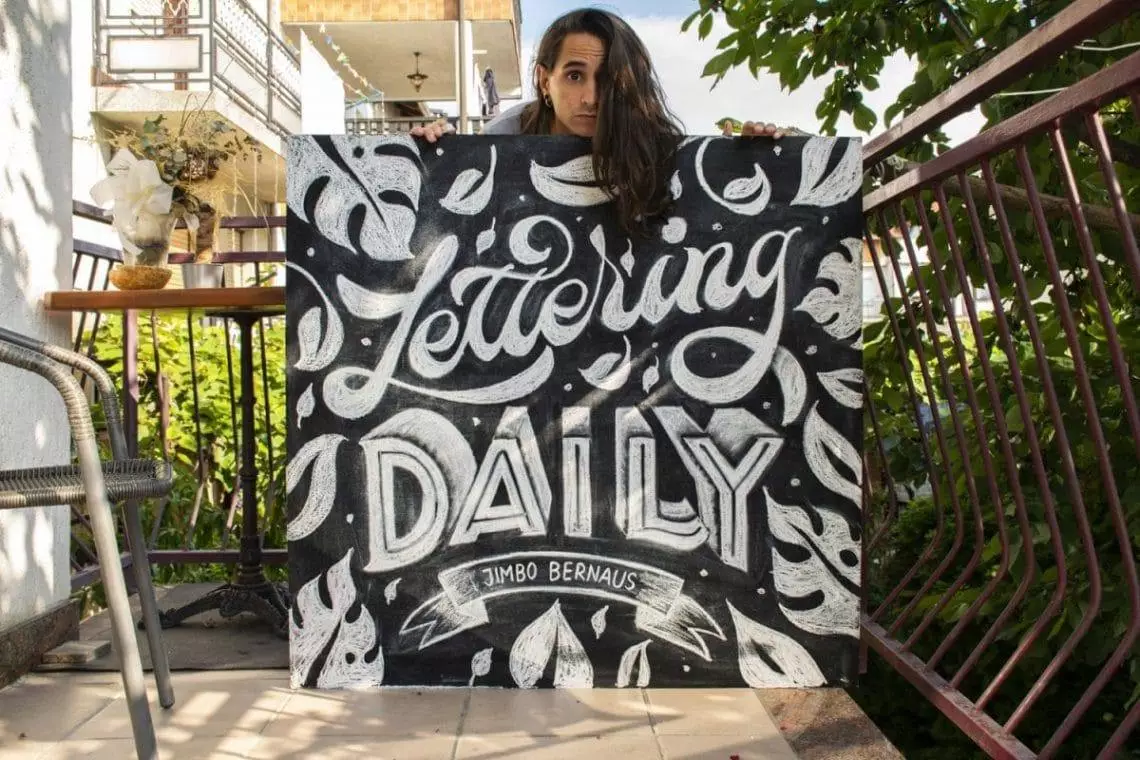
Why does all this matter?
It matters because then we can go around and police people when they use the wrong term.
Just kidding.
The answer to this question is subjective and depends from person to person. As a hand lettering and calligraphy artist, I believe that understanding the terminology and the different art forms is of high importance.
These art forms are complex in their own way and they take years of studying and practice to master. Understanding the basic terminology is kinda like ground 0, and I truly believe that you can only benefit from understanding it.
Perhaps someone who isn’t that invested in this whole world won’t really care that much about the different terms and simply call everything fonts. And you would be surprised to see how often that happens.
The bottom line is – if you want to learn the art of hand lettering & calligraphy, learning and understanding the proper terminology will help you immensely along the way.
Summing it all up – final words.
Ok, so let’s recap everything we just talked about once again.
Hand lettering is an art form that focuses on drawing/illustrating the letters.
Calligraphy is an art form that focuses on the beautiful writing of letters.
Typography is an art form that arranges letters (fonts) in a clear, readable, and visually appealing manner.
Remember – the difference is in the process, not the end result.
With time you’ll train your eye to spot these different art forms with ease.
Which art form do you prefer – calligraphy or lettering?
Let me know by dropping a comment below.
If you have any questions or wishes for future articles and tutorials, be sure to let me know.
Until the next time,
Stay AWESOME!
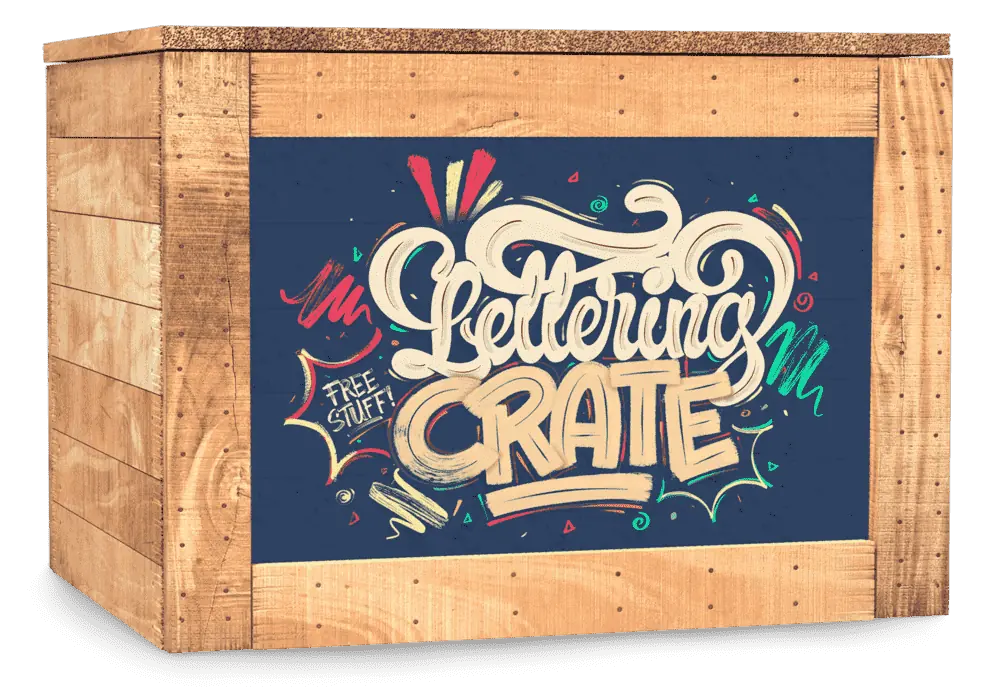
Stay updated with my tutorials and get instant access to the Lettering Crate –
A growing library of free lettering & calligraphy resources that includes –
Pin me!
About the author

Hey, I’m Max Juric, and I’m deeply passionate about calligraphy and hand lettering.
I’ve spent years honing my skills in the art of lettering, working with hundreds of clients from all over the world on design projects such as logotypes, branding, custom lettering, murals, and more.
But my journey doesn’t end there. I’ve also dedicated myself to sharing my knowledge and expertise with others, creating a wealth of resources including tutorials, articles, and podcasts.
It’s been incredibly rewarding to see thousands of people engaging with my content each month. Knowing that I’m helping fellow enthusiasts grow and develop their skills makes me really happy.
Welcome to Lettering Daily, your hub for all things lettering and calligraphy. Whether you’re a seasoned pro or just starting out, I’m here to inspire and guide you on your lettering journey. Stick around, and let’s explore the world of letters together!



Hello. I really love calligraphy and i have been practising using a ballpoint pen. I even learnt gothic calligraphy and some others. The main problem is that it seems that most shops dont have the necessary calligraphy tools in my country, Nigeria. Any suggestion?
Your best chance is to order the supplies online.
Wow!! Thanks for the article, I’ve confused for a long time about this difference between Hand-lettering and calligraphy, always with my mom, we talk about this and we ending argued… Jejejeje… But thank you, REALLY. I know now the true, “difference is the method used to create the letters…” Blessings…
Atte: Niredli OM
heheh, yup. The difference is in the process and not the end result 🙂
My aim is to become a calligrapher. I use a flat brush for writing charts for students (I am a teacher). I am not interested in drawing letters. I live strokes that lead to letters.
That’s great! We all have our own tastes and preferences. If you enjoy more writing than drawing, then just focus on that more 🙂
Can i know about how much can i make by becoming a hand lettering artist? Where can i earn the most ? Will i be able to live a confortable life with it?
Hey Sonal, im afraid it would take me way too long to answer these questions. It’s not as easy as to give you a fixed number. In short – it depends. You can make a lot of money or nothing at all. It depends on a variety of factors including skills, experience, the way you advertise your skills. As for where to earn the most, again it’s difficult to say. Some make more by freelancing, others by selling products. I know many (including myself) who make a living drawing and writing letters, at the same time I know a lot who struggle to make it through the other side. I’ve been planning to make a business section on this website where i can cover these sorts of topics.
Thank you for the wonderful article. I am trying to start my Calligraphy journey and the articles out there are very confusing. This article puts things in perspective (Especially note style vs font). Im looking forward to reading your articles on Traditional calligraphy and exploring the different styles, tools.
Thank you so much for the kind comments. Im glad you’ve found value in my article. If you need any help, don’t hesitate to reach out 🙂
Thankyou! It is beautifully written. Full of knowledge.
Had a question in mind: What are those fine differences that you have started to notice between calligraphy and hand lettering after practicing these art forms over the years now?
Thank you, Asmita! I really appreciate it 🙂 The main difference is the process of creation. Over the years I’ve worked with so many different tools and now when I see a piece of artwork I can already tell if it was written or drawn. I think it comes down to developing your ”artistic eye”. The more you look at things the more you start noticing all these small things the untrained eye cannot see. Hope it makes sense 😀
This was a very well written article. Thank you. I am an old (some would say too old) calligrapher who is very traditional. I have tried to get my output to be “perfect,” which is impossible, of course. One of the things that has made it more possible is the use of the computer to digitally edit the work with a graphics program. I see this is also “hand made” calligraphy, but it involves drawing and editing the “true” calligraphy with digital modification. More like lettering, in a way.
I can take a blackletter piece and edit the edges and points of the letters using a program like Krita to make it perfect down to the pixel! I can also change the color and saturation of each letter, adjust lines for leveling, move letters and words around to get spacing just the way I want, etc. I can incorporate drawings into the piece as overlays, backgrounds, etc. using layers, and the end results are a single graphic (usually a jpg or gif, but I also use png files during the process.
My goal always was (and still is) to produce a unique, finished, piece of calligraphy which can be mounted “as is” complete with mistakes corrected on the original. But I can make scanned and edited copies which can be copied and modified to a client’s desires. If a client wants a specif Pantone color for the lettering, I can do it almost exactly and print it out on good Bristol board. Is that calligraphy? Lettering? Digital art? I don’t know. I’m not even sure I care.
At 81 I don’t have the time (really) to skip these shortcuts. I’ve been doing calligraphy for over 50 years now, and I find myself filled with desire to learn and use lettering for some of my work. I still can’t embellish with flourishes! There is so much to learn!
Thank you for taking the time to explain so much to so many. How about mentioning digital art when you get around to it?
Gary
Thank you so much for your comment, Gary! I really appreciate you taking the time. I have a whole section on iPad lettering and I am starting to focus more and more on the whole digital aspect. I have too many ideas but not enough time to execute all of them 😀
Hey there! Great article and really superb examples. I admire your simple and straightforward writing style too! Definitely my go to article now for explaining the differences to my friends. Breaking down the other popular methods was fun too like faux calligraphy. I’m a calligrapher myself but am interested in all things letters. Keep it up friend!
Thank you, Aaron! It really means a lot 🙂
Wow I loved everything you have shared .I have always been interested in lettering and it’s many forms and the history also.i am excited about learning more and trying new styles and methods. Thankyou so much for sharing your skills and passion .This group is wonderfulThanks a.gain for the opportunity to grow and get better and to just keep trying
Always a pleasure, Toni! Thank you for taking the time and writing such a kind comment. Glad to have you in this community!
Thanks so much for the work
Thank you for reading! Im updating this piece soon! I just need a bit of time 😀 Never enough time!
Oh my. I am stunned. Thanks for this article. I’ve been really good with my penmanship for as long as I can remember, and also a letter-art lover in general but this! Thanks once again. I am a Nigerian in my 30’s and I wish to begin this [Hand Lettering] as a niche industry here. Any advice for individuals like me who want to start this as a business?
Hey Norbert, thank you for your kind words. I really appreciate it 🙂 If i can share a quick tip on starting a business its – find a niche market and do everything online 😀 However, the topic is more complex and would require much more than just an article or a video to explain.
Right on, yeah ur lessons on calligraphy and hand lettering were really great I found them very informative I’ve been doing calligraphy and hand lettering for a couple decades and am self taught so it was all trial and error w a few pointers from some different sources along the way and def learned some stuff from reading this tutorial on too bad Lindsey couldn’t grasp it but I did haha . Thanks for sharing ur knowledge
Thank you so much for your comment! 🙂
Thx for clarifying! My favorite is hand lettering, and i still remember how satisfying it was when i figured out how to draw letters as a kid, though i never knew what that was called. i would love to get more serious about practicing and learning letterforms, but mostly i just draw letters freehand as fast as possible and improvise variations on letterforms, usually while i’m listening to a lecture and an interesting phrase jumps out at me.
Thank you for the comment, Zoe! If you enjoy doing what you do then continue doing it by all means! For me the most important aspect is to enjoy the process, otherwise, what’s the point? 😀
I still don’t understand the difference, wouldn’t hand lettering be considered a type of calligraphy if calligraphy is just the art of writing beautifully ? I have a calligraphy for beginners book and it says when writing calligraphy think of it as more you are drawing the letters rather than writing them….then it shows how to do modern calligraphy with upstrokes and downstrokes and how you can simply fill in the downstrokes thicker with any writing utensil and that’s modern calligraphy….. so since you’re pretty much drawing the letters isn’t modern calligraphy hand lettering ? I’m so confused, I feel like calligraphy is the broad term for the overall beautiful writing styles and you use hand lettering to achieve calligraphy by drawing or illustrating the letters to create beautiful writing (aka calligraphy)….. so they would be one and the same…. my head hurts , is there a very straightforward way to decipher the two? Or better yet could you give two examples of calligraphy and two examples of hand lettering?
Basically in my head I ordered a Chinese calligraphy set and workbook, a copper dip pen and workbook, and a calligraphy for beginners using brush strokes and modern calligraphy with a set of four refillable calligraphy pens labeled “brush”, “medium”, “fine”, and “extra-fine”…. alll these tools in my hand will have different ways to “illustrate” letters using hand lettering, all of which are beautiful forms of writing (calligraphy). No? Is hand lettering the verb and calligraphy the noun and/or adjective?
Hey Lindsey, thank you for your comment and im sorry to hear you have a hard time understanding the difference. I hope i can clear things out for you. Both hand lettering and calligraphy deal with letters – creating them in a beautiful way. The difference between the two is how you create them. Calligraphy is all about writing with specific tools (depending on the script) while hand lettering is about drawing (illustrating) the letters. Sure, you could draw the letterforms and make them look like a calligraphic script – but it would take you much longer. The thing that your book talks about is also known as Faux (fake) calligraphy. Modern calligraphy could be any script/style that deviates from traditional calligraphy scripts, and narrowing it down to one particular thing is simply wrong. Today’s book may teach you some basic skills about lettering or calligraphy but they are really poor with the terminology, and often time can leave the reader confused. Essentially calligraphy and hand lettering are quite different from each other, and if you shoot me a DM on Instagram i’ll be happy to shoot you some examples of the two in order to clear out the confusion.
I’d say for the most part, calligraphy is creating the letter forms, where hand-lettering is using those letterforms to design a piece for a specific purpose. As an example, writing “James & Judy 11-30-2019″ in a Spencerian-style hand would be calligraphy, but spacing them out on an 11″ x 14” parchment, exaggerating the letterforms, and adding flourishes might come closer to hand-lettering – as would embellishing the thicker lines with fine flourishes of gold leaf and using a dry brush to add drop shadows behind the letters.
Hey Tmana, thank you for your comment. Im not 100% sure I know to which piece you are referring to. Perhaps you can send me an email or via Instagram so I could give you my opinion. The difference between the two techniques is actually very simple and straightforward. One is writing the other one is drawing. Flourishing is a part of lettering as it is of calligraphy, and can be created with both methods. Let me know if you have any questions in regards to this topic, I am happy to help 🙂
Great information but some glaring grammatical errors. (Sorry. I’m a professional proofreader.) I’d suggest having someone with the proper training look over your writing before publishing.
Hey Debra, thank you for your comment. I will definitely update the article as soon as i can!
If you’re a professional proofreader I think that’s awesome,. Isn’t that called an editor? just curious. Do you typically offer unsolicited advice everytime you read someone’s work though? I ask only because I can’t help but equate it to myself, being a clinical counselor, and telling people they’re enabling or doing something maladaptive in their lives without them asking for my help or assistance…… Just a thought. People type out things quickly to achieve a quick goal and grammar isn’t always at the forefront of their priorities….yet they can still get their message across as long as it’s legible. Keep in mind anyone who didn’t go to college most likely doesn’t even know how to write 100% grammatically correct, therefore, your comment could be taken as condescending or cavalier. I am not trying to be confrontational, merely expressing a thought.
Ironically your comment isn’t grammatically correct either as periods should be outside the parentheses and “sorry” shouldn’t be capitalized since you don’t start a new sentence in parentheses ??
Thank you for this informative article. I’m looking forward to spending time reestablishing my calligraphy skills, learning brush lettering and learning about hand lettering-as health and focus permit.
You are very welcome, happy to hear that you found it useful 🙂 It’s great to hear that you are coming back to the world of calligraphy and if you need some feedback on your work and some additional tips and resources, be sure to check out our Facebook group. W
Quicky informative..
Thank you very much …
thank you!
im a bginr. .and honestly i was one of those,whose been confused of hand lettering wd calligraphy…thanks for this…
There is a lot of people who don’t know this basic difference and they tend to use the terms as they feel.
However, as you can see in this article, the difference is pretty obvious 😀